List of space telescopes
From Wikipedia, the free encyclopedia
This list of space telescopes (astronomical space observatories) is grouped by major frequency ranges: gamma ray, x-ray, ultraviolet, visible, infrared, microwave, and radio. Telescopes that work in multiple frequency bands are included in all of the appropriate sections. Space telescopes that collect particles, such as cosmic ray nuclei and/or electrons, as well as instruments that aim to detect gravitational waves, are also listed. Missions with specific targets within the Solar System (e.g., the Sun and its planets), are excluded; see List of Solar System probes for these, and List of Earth observation satellites for missions targeting Earth.



Two values are provided for the dimensions of the initial orbit. For telescopes in Earth orbit, the minimum and maximum altitude are given in kilometers. For telescopes in solar orbit, the minimum distance (periapsis) and the maximum distance (apoapsis) between the telescope and the center of mass of the Sun are given in astronomical units (AU).
Gamma ray
Gamma-ray telescopes collect and measure individual, high energy gamma rays from astrophysical sources. These are absorbed by the atmosphere, requiring that observations are done by high-altitude balloons or space missions. Gamma rays can be generated by supernovae, neutron stars, pulsars and black holes. Gamma ray bursts, with extremely high energies, have also been detected but have yet to be identified.[1]
| Photo | Name | Space agency | Launch date | Terminated | Location | Ref(s) |
|---|---|---|---|---|---|---|
 | Proton-1 | USSR | 16 Jul 1965 | 11 Oct 1965 | Earth orbit (183-589 km) | [2] |
 | Proton-2 | USSR | 2 Nov 1965 | 6 Feb 1966 | Earth orbit (191-637 km) | [2] |
 | Proton-4 | USSR | 16 Nov 1968 | 24 Jul 1969 | Earth orbit (248-477 km) | [3] |
 | Small Astronomy Satellite 2 (SAS-B) | NASA | 15 Nov 1972 | 8 Jun 1973 | Earth orbit (443–632 km) | [4][5] |
 | Cos-B | ESA | 9 Aug 1975 | 25 Apr 1982 | Earth orbit (339.6–99,876 km) | [6][7][8] |
 | High Energy Astronomy Observatory 3 | NASA | 20 Sep 1979 | 29 May 1981 | Earth orbit (486.4–504.9 km) | [9][10][11] |
 | Granat | CNRS & IKI | 1 Dec 1989 | 25 May 1999 | Earth orbit (2,000–200,000 km) | [12][13][14] |
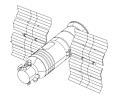 | Gamma | USSR, CNES, RSA | 11 Jul 1990 | 1992 | Earth orbit (375 km) | [15] |
 | Compton Gamma Ray Observatory (CGRO) | NASA | 5 Apr 1991 | 4 Jun 2000 | Earth orbit (362–457 km) | [16][17][18] |
| Low Energy Gamma Ray Imager (LEGRI) | INTA | 19 May 1997 | Feb 2002 | Earth orbit (600 km) | [19][20] | |
 | High Energy Transient Explorer 2 (HETE 2) | NASA | 9 Oct 2000 | Mar 2008 | Earth orbit (590–650 km) | [21][22][23] |
| International Gamma Ray Astrophysics Laboratory (INTEGRAL) | ESA | 17 Oct 2002 | — | Earth orbit (639–153,000 km) | [24][25] | |
 | Neil Gehrels Swift Observatory | NASA | 20 Nov 2004 | — | Earth orbit (585–604 km) | [26][27] |
 | Astrorivelatore Gamma ad Immagini Leggero (AGILE) | ISA | 23 Apr 2007 | 18 Jan 2024 | Earth orbit (524–553 km) | [28][29] |
| Fermi Gamma-ray Space Telescope | NASA | 11 Jun 2008 | — | Earth orbit (555 km) | [30] | |
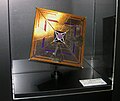 | Gamma-Ray Burst Polarimeter (IKAROS) | JAXA | 21 May 2010 | 21 May 2015 | Heliocentric orbit | [31][32] |
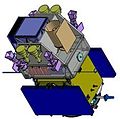 | Space Variable Objects Monitor (SVOM) | CNSA & CNES | 22 Jun 2024 | — | Earth orbit (625–625 km) | [33][34] |
X-ray
X-ray telescopes measure high-energy photons called X-rays. These can not travel a long distance through the atmosphere, meaning that they can only be observed high in the atmosphere or in space. Several types of astrophysical objects emit X-rays, from galaxy clusters, through black holes in active galactic nuclei to galactic objects such as supernova remnants, stars, and binary stars containing a white dwarf (cataclysmic variable stars), neutron star or black hole (X-ray binaries). Some Solar System bodies emit X-rays, the most notable being the Moon, although most of the X-ray brightness of the Moon arises from reflected solar X-rays. A combination of many unresolved X-ray sources is thought to produce the observed X-ray background.
| Photo | Name | Space agency | Launch date | Terminated | Location | Ref(s) |
|---|---|---|---|---|---|---|
 | Uhuru (Small Astronomy Satellite 1, SAS-A) | NASA | 12 Dec 1970 | Mar 1973 | Earth orbit (531–572 km) | [35][36][37] |
 | Astronomical Netherlands Satellite (ANS) | SRON | 30 Aug 1974 | Jun 1976 | Earth orbit (266–1176 km) | [38][39] |
 | Ariel V | SRC & NASA | 15 Oct 1974 | 14 Mar 1980 | Earth orbit (520 km) | [40][41] |
 | Aryabhata | ISRO | 19 Apr 1975 | 23 Apr 1975 | Earth orbit (563–619 km) | [42] |
 | Small Astronomy Satellite 3 (SAS-C) | NASA | 7 May 1975 | Apr 1979 | Earth orbit (509–516 km) | [43][44][45] |
 | Cos-B | ESA | 9 Aug 1975 | 25 Apr 1982 | Earth orbit (339.6–99,876 km) | [6][7][8] |
| Cosmic Radiation Satellite (CORSA) | ISAS | 4 Feb 1976 | 4 Feb 1976 | Failed launch | [46][47] | |
 | High Energy Astronomy Observatory 1 (HEAO 1) | NASA | 12 Aug 1977 | 9 Jan 1979 | Earth orbit (445 km) | [48][49][50] |
 | Einstein Observatory (HEAO 2) | NASA | 13 Nov 1978 | 26 Apr 1981 | Earth orbit (465–476 km) | [51][52] |
 | Hakucho (CORSA-b) | ISAS | 21 Feb 1979 | 16 Apr 1985 | Earth orbit (421–433 km) | [53][54][55] |
 | High Energy Astronomy Observatory 3 (HEAO 3) | NASA | 20 Sep 1979 | 29 May 1981 | Earth orbit (486.4–504.9 km) | [9][10][11] |
 | Tenma (Astro-B) | ISAS | 20 Feb 1983 | 19 Jan 1989 | Earth orbit (489–503 km) | [56][57][58] |
 | Astron | IKI | 23 Mar 1983 | Jun 1989 | Earth orbit (2,000–200,000 km) | [59][60][61] |
 | EXOSAT | ESA | 26 May 1983 | 8 Apr 1986 | Earth orbit (347–191,709 km) | [62][63][64] |
 | Ginga (Astro-C) | ISAS | 5 Feb 1987 | 1 Nov 1991 | Earth orbit (517–708 km) | [65][66][67] |
 | Granat | CNRS & IKI | 1 Dec 1989 | 25 May 1999 | Earth orbit (2,000–200,000 km) | [12][13][14] |
| ROSAT | NASA & DLR | 1 Jun 1990 | 12 Feb 1999 | Re-entry 23 October 2011.[68] Formerly Earth orbit (580 km) | [69][70][71] | |
 | Broad Band X-ray Telescope / Astro 1 | NASA | 2 Dec 1990 | 11 Dec 1990 | Earth orbit (500 km) | [72][73] |
 | Advanced Satellite for Cosmology and Astrophysics (ASCA, Astro-D) | ISAS & NASA | 20 Feb 1993 | 2 Mar 2001 | Earth orbit (523.6–615.3 km) | [74][75] |
 | Array of Low Energy X-ray Imaging Sensors (Alexis) | LANL | 25 Apr 1993 | 2005 | Earth orbit (749–844 km) | [76][77][78] |
 | Rossi X-ray Timing Explorer (RXTE) | NASA | 30 Dec 1995 | 3 Jan 2012 | Earth orbit (409 km) | [79][80][81] |
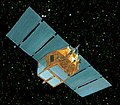 | BeppoSAX | ASI | 30 Apr 1996 | 30 Apr 2002 | Earth orbit (575–594 km) | [82][83][84] |
 | A Broadband Imaging X-ray All-sky Survey (ABRIXAS) | DLR | 28 Apr 1999 | 1 Jul 1999 | Earth orbit (549–598 km) | [85][86][87] |
 | Chandra X-ray Observatory | NASA | 23 Jul 1999 | — | Earth orbit (9,942–140,000 km) | [88][89] |
| XMM-Newton | ESA | 10 Dec 1999 | — | Earth orbit (7,365–114,000 km) | [90][91] | |
 | High Energy Transient Explorer 2 (HETE 2) | NASA | 9 Oct 2000 | Mar 2008 | Earth orbit (590–650 km) | [21][22][92] |
| International Gamma Ray Astrophysics Laboratory (INTEGRAL) | ESA | 17 Oct 2002 | — | Earth orbit (639–153,000 km) | [24][25] | |
 | Neil Gehrels Swift Observatory | NASA | 20 Nov 2004 | — | Earth orbit (585–604 km) | [26][27] |
 | Suzaku (Astro-E2) | JAXA & NASA | 10 Jul 2005 | 2 Sep 2015 | Earth orbit (550 km) | [93][94] |
 | Astrorivelatore Gamma ad Immagini Leggero (AGILE) | ISA | 23 Apr 2007 | 18 Jan 2024 | Earth orbit (524–553 km) | [28][29] |
 | Nuclear Spectroscopic Telescope Array (NuSTAR) | NASA | 13 Jun 2012 | — | Earth orbit (603.5 km) | [95][96] |
 | AstroSat | ISRO | 28 Sep 2015 | — | Earth orbit (600–650 km) | [97][98][99] |
 | Hitomi (Astro-H) | JAXA | 17 Feb 2016 | 28 Apr 2016 | Earth orbit (575 km) | [100][101][102] |
 | Mikhailo Lomonosov | Moscow State University | 28 Apr 2016 | 30 Jun 2018 | Earth orbit (478–493 km) | [103][104] |
 | Neutron Star Interior Composition Explorer (NICER) | NASA | 7 Jun 2017 | — | International Space Station | [105] |
 | Hard X-ray Modulation Telescope (HXMT) | CNSA & CAS | 14 Jun 2017 | — | Low Earth orbit (545–554.1 km) | [106] |
 | Spektr-RG | RSRI & MPE | Jul 13, 2019 | — | Sun-Earth L2 | [107] |
 | Imaging X-ray Polarimetry Explorer (IXPE) | NASA | 9 Dec 2021 | — | Earth orbit (540 km) | [108][109] |
| Lobster Eye Imager for Astronomy (LEIA) | CAS | 27 Jul 2022 | — | Low Earth orbit | [110][111] | |
 | X-ray Imaging and Spectroscopy Mission (XRISM) | JAXA & NASA | 7 Sep 2023 | — | Earth orbit (550 km) | [112][113] |
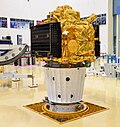 | X-ray Polarimeter Satellite (XPoSat) | ISRO & RRI | 1 Jan 2024 | — | Earth orbit (638–653 km) | [114][115] |
| Einstein Probe | CAS & ESA & MPE | 9 Jan 2024 | — | Earth orbit (581–593 km) | [116] | |
 | Space Variable Objects Monitor (SVOM) | CNSA & CNES | 22 Jun 2024 | — | Earth orbit (625–625 km) | [33][117] |
Ultraviolet
Summarize
Perspective
Ultraviolet telescopes make observations at ultraviolet wavelengths, i.e. between approximately 10 and 320 nm. Light at these wavelengths is absorbed by the Earth's atmosphere, so observations at these wavelengths must be performed from the upper atmosphere or from space.[118] Objects emitting ultraviolet radiation include the Sun, other stars and galaxies.[119]
| Photo | Name | Space agency | Launch date | Terminated | Observing location | Ref(s) |
|---|---|---|---|---|---|---|
 | OAO-2 (Stargazer) | NASA | 7 Dec 1968 | Jan 1973 | Earth orbit (749–758 km) | [120][121] |
| Orion 1 and Orion 2 Space Observatories | USSR | 19 Apr 1971 (Orion 1); (Orion 2) 18 Dec 1973 | 1971; 1973 | Earth orbit (Orion 1: 200–222 km; Orion 2: 188–247 km) | [122][123] | |
 | Far Ultraviolet Camera/Spectrograph (UVC) | NASA | 16 Apr 1972 | 23 Apr 1972 | Descartes Highlands on lunar surface | [124] |
 | OAO-3 Copernicus | NASA | 21 Aug 1972 | Feb 1981 | Earth orbit (713–724 km) | [120] |
 | Astronomical Netherlands Satellite (ANS) | SRON | 30 Aug 1974 | Jun 1976 | Earth orbit (266–1176 km) | [38][39] |
 | International Ultraviolet Explorer (IUE) | ESA & NASA & SERC | 26 Jan 1978 | 30 Sep 1996 | Earth orbit (32,050–52,254 km) | [125][126] |
 | Astron | IKI | 23 Mar 1983 | Jun 1989 | Earth orbit (2,000–200,000 km) | [59][60][61] |
 | Hubble Space Telescope | NASA & ESA | 24 Apr 1990 | — | Earth orbit (586–610 km) | [127] |
 | Broad Band X-ray Telescope / Astro 1 | NASA | 2 Dec 1990 | 11 Dec 1990 | Earth orbit (500 km) | [72][73] |
 | Extreme Ultraviolet Explorer (EUVE) | NASA | 7 Jun 1992 | 31 Jan 2001 | Earth orbit (515–527 km) | [128][129] |
 | Astro 2 | NASA | 2 Mar 1993 | 18 Mar 1993 | Earth orbit (349–363 km) | [130][131] |
 | Far Ultraviolet Spectroscopic Explorer (FUSE) | NASA & CNES & CSA | 24 Jun 1999 | 12 Jul 2007 | Earth orbit (752–767 km) | [132][133] |
 | Cosmic Hot Interstellar Spectrometer (CHIPS) | NASA | 13 Jan 2003 | 11 Apr 2008 | Earth orbit (578–594 km) | [134][135] |
 | Galaxy Evolution Explorer (GALEX) | NASA | 28 Apr 2003 | 28 Jun 2013 | Earth orbit (691–697 km) | .[136][137][138] |
| Korea Advanced Institute of Science and Technology Satellite 4 (Kaistsat 4) | KARI | 27 Sep 2003 | 2007? | Earth orbit (675–695 km) | [139][140] | |
 | Neil Gehrels Swift Observatory (Swift) | NASA | 20 Nov 2004 | — | Earth orbit (585–604 km) | [26][27] |
 | Interface Region Imaging Spectrograph (IRIS) | NASA | 27 Jun 2013 | — | Earth orbit (387–415 km) | [141][142] |
 | Hisaki (SPRINT-A) | JAXA | 14 Sep 2013 | 8 December 2023 | Earth orbit (957–1151 km) | [143][144] |
| Venus Spectral Rocket Experiment | NASA | 26 Nov 2013 | reusable | Suborbital to 300 km | [145] | |
| Lunar-based ultraviolet telescope (LUT) | CNSA | 1 Dec 2013 | — | Lunar surface (On Chang'e 3 lander) | [146] | |
 | AstroSat | ISRO | 28 Sep 2015 | — | Earth orbit (600–650 km) | [98][97][99] |
| Spatial Heterodyne Interferometric Emission Line Dynamics Spectrometer (SHIELDS) | NASA | 19 Apr 2021 | 19 Apr 2021 | Suborbital to 284.8 km | [147] | |
| Colorado Ultraviolet Transit Experiment (CUTE) | NASA, Colorado University | 27 Sep 2021 | nearly Sun-synchronous orbit with a ~90 minute orbital period | [148] |
UV ranges listed at Ultraviolet astronomy#Ultraviolet space telescopes.
Visible light
The oldest form of astronomy, optical or visible-light astronomy, observes wavelengths of light from approximately 400 to 700 nm.[149] Positioning an optical telescope in space eliminates the distortions and limitations that hamper that ground-based optical telescopes (see Astronomical seeing), providing higher resolution images. Optical telescopes are used to look at planets, stars, galaxies, planetary nebulae and protoplanetary disks, amongst many other things.[150]
| Photo | Name | Space agency | Launch date | Terminated | Location | Ref(s) |
|---|---|---|---|---|---|---|
 | Hipparcos | ESA | 8 Aug 1989 | Mar 1993 | Earth orbit (223–35,632 km) | [151][152][153] |
 | Hubble Space Telescope | NASA & ESA | 24 Apr 1990 | — | Earth orbit (586.47–610.44 km) | [127] |
| MOST | CSA | 30 Jun 2003 | Mar 2019 | Earth orbit (819–832 km) | [154][155] | |
 | Neil Gehrels Swift Observatory | NASA | 20 Nov 2004 | — | Earth orbit (585–604 km) | [26][27] |
 | COROT | CNES & ESA | 27 Dec 2006 | 2013 | Earth orbit (872–884 km) | [156][157] |
 | Kepler | NASA | 6 Mar 2009 | 30 Oct 2018 | Earth-trailing heliocentric orbit | [158][159][160] |
 |
BRITE constellation | Austria, Canada, Poland | 25 Feb 2013 - 19 Aug 2014 | — | Earth orbit | [161] |
| Near Earth Object Surveillance Satellite (NEOSSat) | CSA, DRDC | 25 Feb 2013 | — | Sun-synchronous Earth orbit (776–792 km) | [162][163] | |
 | Gaia (astrometry) | ESA | 19 Dec 2013 | — | Sun-Earth L2 Lagrange point | [164] |
 | AstroSat | ISRO | 28 Sep 2015 | — | Earth orbit (600–650 km) | [97][98][99] |
 | Transiting Exoplanet Survey Satellite (TESS) | NASA | 18 Apr 2018 | — | High Earth Orbit | [165] |
| CHEOPS | ESA | 18 Dec 2019 | — | Sun-synchronous orbit | [166] | |
| ILO-X | ILOA | 15 Feb 2024 | — | Lunar surface | [167] | |
 | Space Variable Objects Monitor (SVOM) | CNSA & CNES | 22 Jun 2024 | — | Earth orbit (625–625 km) | [33][168] |
Infrared and submillimetre
Infrared light is of lower energy than visible light, hence is emitted by sources that are either cooler, or moving away from the observer (in present context: Earth) at high speed. As such, the following can be viewed in the infrared: cool stars (including brown dwarves), nebulae, and redshifted galaxies.[169]
| Photo | Name | Space agency | Launch date | Terminated | Location | Ref(s) |
|---|---|---|---|---|---|---|
 | IRAS | NASA | 25 Jan 1983 | 21 Nov 1983 | Earth orbit (889–903 km) | [170] |
 | Infrared Telescope in Space | ISAS & NASDA | 18 Mar 1995 | 25 Apr 1995 | Earth orbit (486 km) | [171][172] |
 | Infrared Space Observatory (ISO) | ESA | 17 Nov 1995 | 16 May 1998 | Earth orbit (1000–70500 km) | [173][174] |
 | Midcourse Space Experiment (MSX) | USN | 24 Apr 1996 | 26 Feb 1997 | Earth orbit (900 km) | [175] |
 | Submillimeter Wave Astronomy Satellite (SWAS) | NASA | 6 Dec 1998 | Last used in 2005 | Earth orbit (638–651 km) | [176] |
 | Wide Field Infrared Explorer (WIRE) | NASA | 5 Mar 1999 | no observations | Re-entered May 10, 2011[177] | [178] |
 | Spitzer Space Telescope | NASA | 25 Aug 2003 | 30 Jan 2020[179] | Solar orbit (0.98–1.02 AU) | [180] |
 | Akari (Astro-F) | JAXA | 21 Feb 2006 | 24 Nov 2011[181] | Earth orbit (586.47–610.44 km) | [182] |
 | Herschel Space Observatory | ESA & NASA | 14 May 2009 [183] | 29 Apr 2013[184] | Sun-Earth L2 Lagrange point | [185][186][187] |
 | Wide-field Infrared Survey Explorer (WISE) | NASA | 14 Dec 2009 | (hibernation Feb 2011 – Aug 2013) | Earth orbit (500 km) | [188][189][190] |
 | CHEOPS | ESA | 18 Dec 2019 | — | Sun-synchronous orbit | [166] |
 |
James Webb Space Telescope (JWST) | NASA/ESA/CSA | 25 Dec 2021 | — | Sun–Earth L2 Lagrange point | [191] |
 | Euclid | ESA | 1 Jul 2023 | — | Sun–Earth L2 Lagrange point | [192][193] |
 | SPHEREx | NASA | 11 Mar 2025 | — | Earth orbit | [194] |
Microwave
Microwave space telescopes have primarily been used to measure cosmological parameters from the Cosmic Microwave Background. They also measure synchrotron radiation, free-free emission and spinning dust from the Milky Way Galaxy, as well as extragalactic compact sources and galaxy clusters through the Sunyaev-Zel'dovich effect.[195]
| Photo | Name | Space agency | Launch date | Terminated | Location | Ref(s) |
|---|---|---|---|---|---|---|
 | Cosmic Background Explorer (COBE) | NASA | 18 Nov 1989 | 23 Dec 1993 | Earth orbit (900 km) | [196][197] |
| Odin | Swedish Space Corporation | 20 Feb 2001 | — | Earth orbit (622 km) | [198][199] | |
 | WMAP | NASA | 30 Jun 2001 | Oct 2010 | Sun-Earth L2 Lagrange point | [200] |
 | Planck | ESA | 14 May 2009 | Oct 2013 | Sun-Earth L2 Lagrange point (mission) Heliocentric (Derelict) | [186][201][202] |
Radio
As the atmosphere is transparent for radio waves, radio telescopes in space are most useful for Very Long Baseline Interferometry: doing simultaneous observations of a source with both a satellite and a ground-based telescope and by correlating their signals to simulate a radio telescope the size of the separation between the two telescopes. Typical targets for observations include supernova remnants, masers, gravitational lenses, and starburst galaxies.[citation needed]
| Photo | Name | Space agency | Launch date | Terminated | Location | Ref(s) |
|---|---|---|---|---|---|---|
 | Highly Advanced Laboratory for Communications and Astronomy (HALCA, VSOP or MUSES-B) | ISAS | 12 Feb 1997 | 30 Nov 2005 | Earth orbit (560–21,400 km) | [203][204][205] |
 | Spektr-R (RadioAstron) | ASC LPI | 18 Jul 2011 | 11 Jan 2019 | Earth orbit (10,000–390,000 km) | [206][207][208] |
Particle detection
Spacecraft and space-based modules that do particle detection, looking for cosmic rays and electrons. These can be emitted by the Sun (Solar Energetic Particles), the Milky Way galaxy (Galactic cosmic rays) and extragalactic sources (Extragalactic cosmic rays). There are also Ultra-high-energy cosmic rays from active galactic nuclei, those can be detected by ground-based detectors via their particle showers.
| Photo | Name | Space agency | Launch date | Terminated | Location | Ref(s) |
|---|---|---|---|---|---|---|
 | Proton-1 | USSR | 16 Jul 1965 | 11 Oct 1965 | Earth orbit (589–183 km) | [2] |
 | Proton-2 | USSR | 2 Nov 1965 | 6 Feb 1966 | Earth orbit (637–191 km) | [2] |
 | High Energy Astronomy Observatory 3 (HEAO 3) | NASA | 20 Sep 1979 | 29 May 1981 | Earth orbit (486.4–504.9 km) | [9][10][11] |
 | SAMPEX | NASA / DE | 3 Jul 1992 | 30 Jun 2004 | Earth orbit (512–687 km) | [209] |
 | Alpha Magnetic Spectrometer 01 (AMS-01) | NASA | 2 Jun 1998 | 12 Jun 1998 | Earth orbit (296 km) | [210] |
 | Payload for Antimatter Matter Exploration and Light-nuclei Astrophysics (PAMELA) | ISA, INFN, RSA, DLR & SNSB | 15 May 2006 | 7 Feb 2016 | Earth orbit (350–610 km) | [211][212] |
 | IBEX | NASA | 19 Oct 2008 | — | Earth orbit (86,000–259,000 km) | [213] |
 | Alpha Magnetic Spectrometer 02 (AMS-02) | NASA | 16 May 2011 | — | Earth orbit (353 km) on ISS | [214] |
| Calorimetric Electron Telescope (CALET) | JAXA | 19 Oct 2015 | — | Earth orbit (353 km) on ISS | [215] | |
| Dark Matter Particle Explorer (DAMPE) | CNSA & CAS | 17 Dec 2015 | — | Earth orbit (500 km) | [216] |
Gravitational waves
A type of telescope that detects gravitational waves; ripples in space-time generated by colliding neutron stars or black holes.
| Photo | Name | Space agency | Launch date | Terminated | Location | Ref(s) |
|---|---|---|---|---|---|---|
 | Lunar Surface Gravimeter | NASA | 7 Dec 1972 | 14 Dec 1972 | Taurus–Littrow | [217] |
Future launches
| Photo | Name | Space agency | Planned launch date | Location | Ref(s) |
|---|---|---|---|---|---|
 | Interstellar Mapping and Acceleration Probe | NASA | 2025 | L1 Lagrange point | [218] |
 | Xuntian | CNSA/CAS | 2026 | Low Earth orbit | [219][220][221] |
 | PLATO | ESA | 2026 | Geosynchronous orbit | [222] |
 | ULTRASAT | Israel Space Agency | 2026 | Sun–Earth L2 Lagrange point | [223] |
 | Nancy Grace Roman Space Telescope | NASA | 2027 | Sun–Earth L2 Lagrange point | [224] |
 | Compton Spectrometer and Imager | NASA | 2027 | Low Earth orbit | [225] |
 | ARIEL | ESA | 2029 | Sun–Earth L2 Lagrange point | [226] |
 | UVEX | NASA | 2030 | Highly elliptical orbit | [227] |
| Taiji | CNSA/CAS | 2033 | Heliocentric orbit | [228] | |
| Advanced Telescope for High Energy Astrophysics (Athena) | ESA/NASA/JAXA | 2035 | Sun–Earth L2 Lagrange point | [229] | |
 | Laser Interferometer Space Antenna (LISA) | ESA | 2037 | Heliocentric orbit | [230] |
See also
References
External links
Wikiwand - on
Seamless Wikipedia browsing. On steroids.
